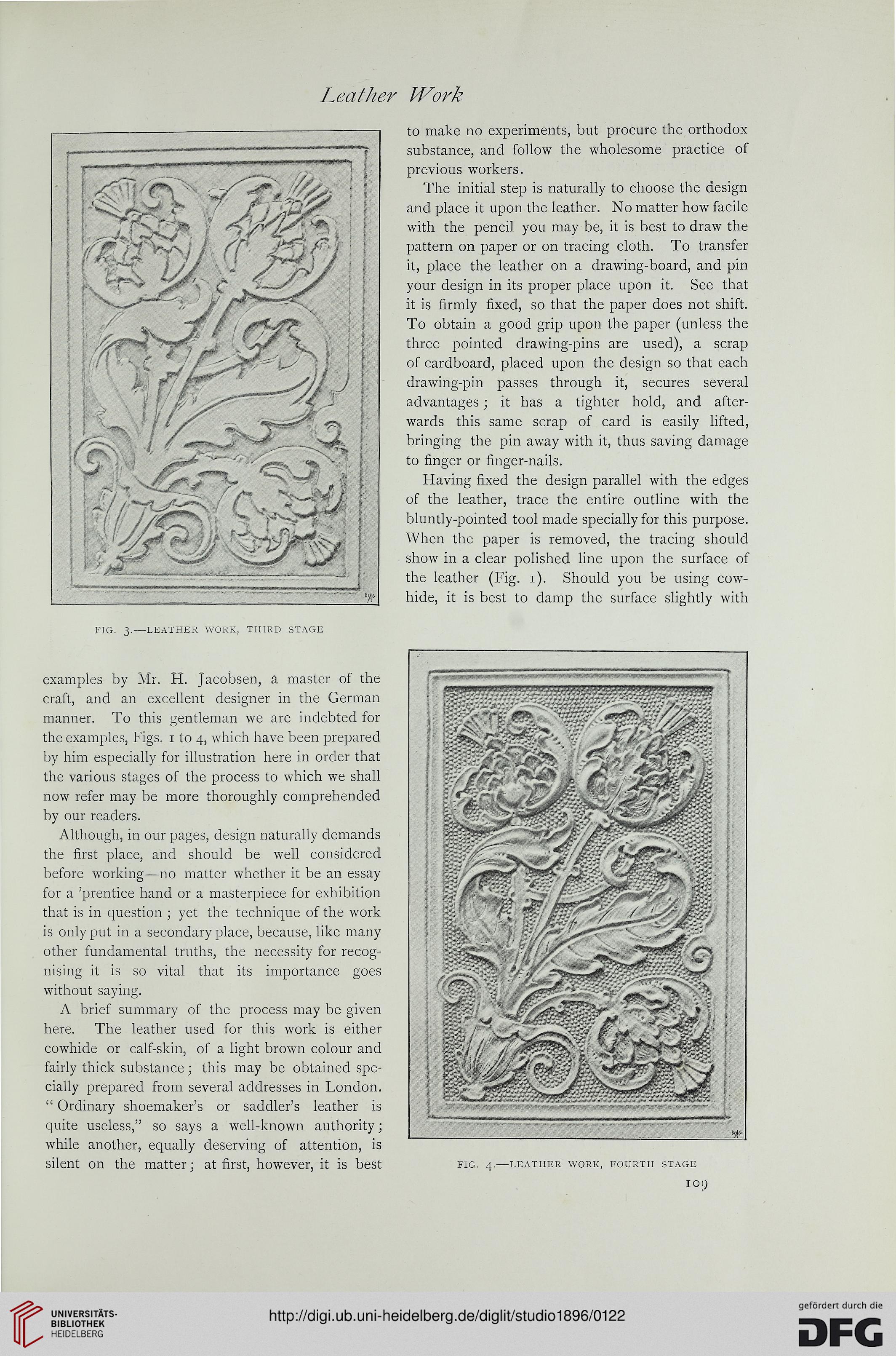FIG. 3.—LEATHER WORK, THIRD STAGE
examples by Mr. H. Jacobsen, a master of the
craft, and an excellent designer in the German
manner. To this gentleman we are indebted for
the examples, Figs. 1 to 4, which have been prepared
by him especially for illustration here in order that
the various stages of the process to which we shall
now refer may be more thoroughly comprehended
by our readers.
Although, in our pages, design naturally demands
the first place, and should be well considered
before working—no matter whether it be an essay
for a 'prentice hand or a masterpiece for exhibition
that is in question ; yet the technique of the work
is only put in a secondary place, because, like many
other fundamental truths, the necessity for recog-
nising it is so vital that its importance goes
without saying.
A brief summary of the process may be given
here. The leather used for this work is either
cowhide or calf-skin, of a light brown colour and
fairly thick substance; this may be obtained spe-
cially prepared from several addresses in London.
" Ordinary shoemaker's or saddler's leather is
quite useless," so says a well-known authority;
while another, equally deserving of attention, is
silent on the matter; at first, however, it is best
to make no experiments, but procure the orthodox
substance, and follow the wholesome practice of
previous workers.
The initial step is naturally to choose the design
and place it upon the leather. No matter how facile
with the pencil you may be, it is best to draw the
pattern on paper or on tracing cloth. To transfer
it, place the leather on a drawing-board, and pin
your design in its proper place upon it. See that
it is firmly fixed, so that the paper does not shift.
To obtain a good grip upon the paper (unless the
three pointed drawing-pins are used), a scrap
of cardboard, placed upon the design so that each
drawing-pin passes through it, secures several
advantages; it has a tighter hold, and after-
wards this same scrap of card is easily lifted,
bringing the pin away with it, thus saving damage
to finger or finger-nails.
Having fixed the design parallel with the edges
of the leather, trace the entire outline with the
bluntly-pointed tool made specially for this purpose.
When the paper is removed, the tracing should
show in a clear polished line upon the surface of
the leather (Fig. 1). Should you be using cow-
hide, it is best to damp the surface slightly with
FIG. 4.—LEATHER WORK, FOURTH STAGE
IOl)
examples by Mr. H. Jacobsen, a master of the
craft, and an excellent designer in the German
manner. To this gentleman we are indebted for
the examples, Figs. 1 to 4, which have been prepared
by him especially for illustration here in order that
the various stages of the process to which we shall
now refer may be more thoroughly comprehended
by our readers.
Although, in our pages, design naturally demands
the first place, and should be well considered
before working—no matter whether it be an essay
for a 'prentice hand or a masterpiece for exhibition
that is in question ; yet the technique of the work
is only put in a secondary place, because, like many
other fundamental truths, the necessity for recog-
nising it is so vital that its importance goes
without saying.
A brief summary of the process may be given
here. The leather used for this work is either
cowhide or calf-skin, of a light brown colour and
fairly thick substance; this may be obtained spe-
cially prepared from several addresses in London.
" Ordinary shoemaker's or saddler's leather is
quite useless," so says a well-known authority;
while another, equally deserving of attention, is
silent on the matter; at first, however, it is best
to make no experiments, but procure the orthodox
substance, and follow the wholesome practice of
previous workers.
The initial step is naturally to choose the design
and place it upon the leather. No matter how facile
with the pencil you may be, it is best to draw the
pattern on paper or on tracing cloth. To transfer
it, place the leather on a drawing-board, and pin
your design in its proper place upon it. See that
it is firmly fixed, so that the paper does not shift.
To obtain a good grip upon the paper (unless the
three pointed drawing-pins are used), a scrap
of cardboard, placed upon the design so that each
drawing-pin passes through it, secures several
advantages; it has a tighter hold, and after-
wards this same scrap of card is easily lifted,
bringing the pin away with it, thus saving damage
to finger or finger-nails.
Having fixed the design parallel with the edges
of the leather, trace the entire outline with the
bluntly-pointed tool made specially for this purpose.
When the paper is removed, the tracing should
show in a clear polished line upon the surface of
the leather (Fig. 1). Should you be using cow-
hide, it is best to damp the surface slightly with
FIG. 4.—LEATHER WORK, FOURTH STAGE
IOl)





